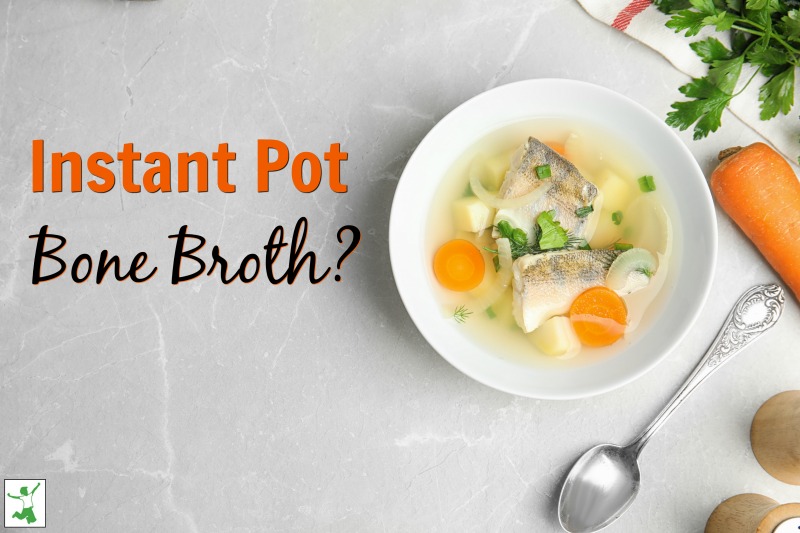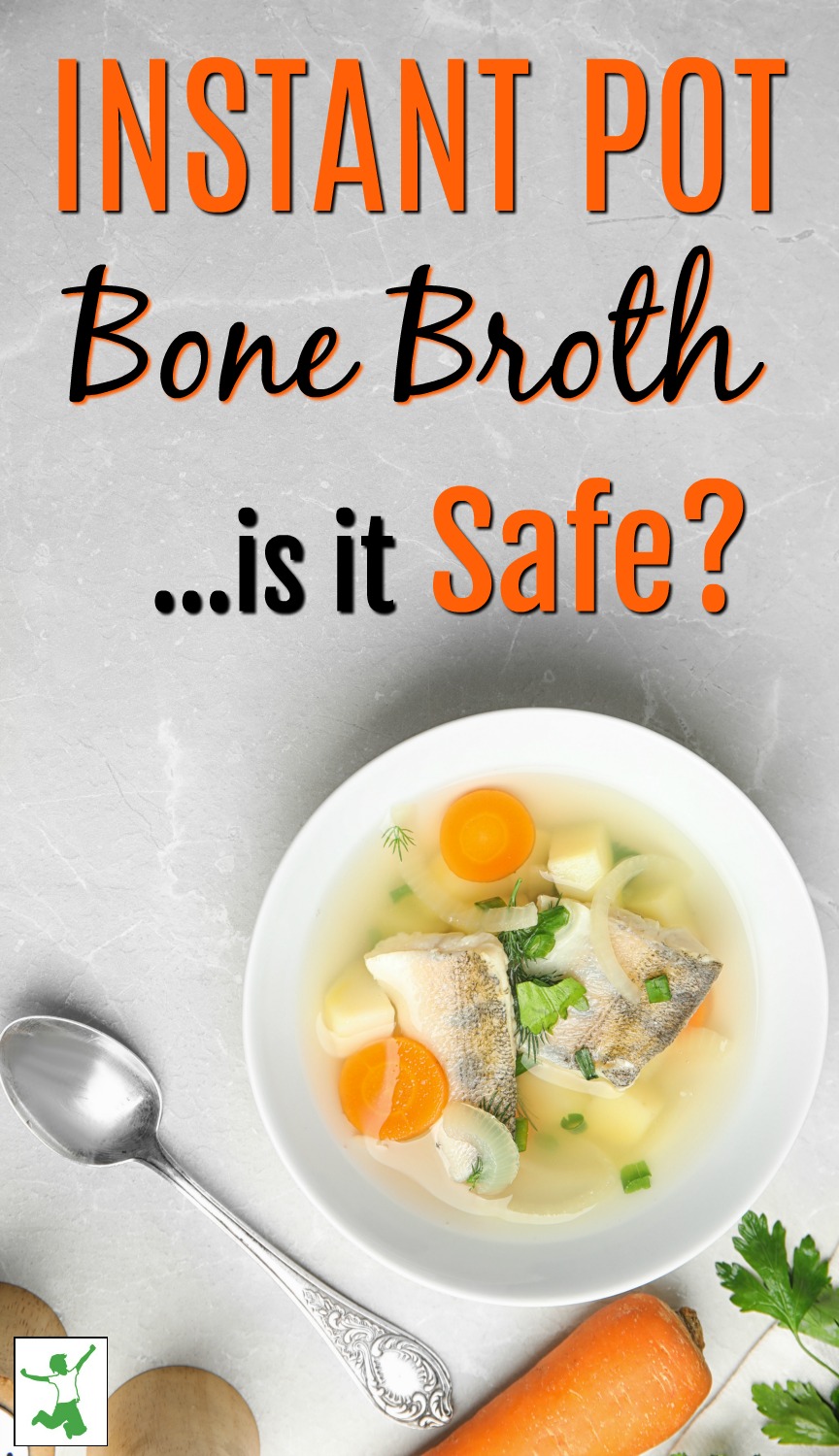Reasons to avoid using a pressure cooker like the Instant Pot for making bone broths and stocks. Three safe, truly inert alternatives to consider instead. 
A common question for those who use an Instant Pot is whether it is safe for making bone broth or meat stock.
In my view, it is best to avoid pressure cookers for these types of dishes for two reasons, which I explore individually below.
Instant Pot for Making Broth
Stainless steel pots and pans and stainless steel lined appliances like the Instant Pot are fine to use for cooking with the exception of acidic foods.
Most people don’t consider bone broth to be acidic, but it most definitely is! Consider that if you make it the traditional way, apple cider vinegar is added at the start.
Stainless steel is often touted as an inert alternative to cookwares with questionable, dangerous non-stick coatings like Teflon that can pollute our air and our food.
However, even high-grade stainless steel (400 series) is far from being completely safe. Specifically, the metal ions from nickel, chromium, and molybdenum can end up in your food as well.
Metals in Stainless Steel
How much leaching is actually happening when you cook with stainless steel? It appears under certain circumstances a substantial amount!
According to the Journal of Agricultural and Food Chemistry:
After a simulated cooking process, samples were analyzed by ICP-MS for Ni [Nickel] and Cr [Chromium]. After six hours of cooking, Ni and Cr concentrations in tomato sauce increased up to 26- and 7-fold respectively, depending on the grade of stainless steel. Longer cooking durations resulted in additional increases in metal leaching, where Ni concentrations increased 34 fold and Cr increased approximately 35 fold from sauces cooked without stainless steel.
Cooking with new stainless steel resulted in the largest increases. Metal leaching decreases with sequential cooking cycles and stabilized after the sixth cooking cycle, though significant metal contributions to foods were still observed. The tenth cooking cycle, resulted in an average of 88 μg [micrograms] of Ni and 86 μg of Cr leached per 126 g serving of tomato sauce. Stainless steel cookware can be an overlooked source of nickel and chromium, where the contribution is dependent on stainless steel grade, cooking time, and cookware usage.
This leaching of heavy metals into food from stainless steel can continue even after years of use.
Cheap grade stainless steel would, of course, be even riskier.
For longer cooking and acidic foods, such as tomato-based sauces or slow simmering of bone broths and stocks, use alternate cookware! I use a Vita-Clay slow cooker, which is apparently more durable than the break-prone Instant Pots too!
MSG and Lost Nutrients from Instant Pot?
Another reason to consider avoiding pressure cookers for making bone broth is the potential for the creation of excessive amounts of glutamate.
While glutamate is not true MSG (which is its factory created mirror image), it will trigger a similar reaction in MSG-sensitive individuals.
Disclaimer: The glutamine levels in pressure cooker bone broth are as yet unknown.
In addition, how pressure cooking affects the nutrients in bone broth is also up in the air.
Here’s what Kaayla Daniel Ph.D., co-author of Nourishing Broth has to say about the effect of a pressure cooker on the nutrients in bone broth:
Pressure cookers seem to help achieve the gelatin we value so much. In terms of nutritional value, we have not done comparison testing of pressure cooker broth vs stockpot vs slow cooker. We’d love to do lab testing for a long lists of nutrients, but that gets very expensive very fast. If you know anyone who’d like to give us about $20,000 for a small study, we’d like to move forward with that testing. In the meantime, I see no reason for you to stop using your pressure cooker. However, we do question pressure cooking for 5 hours. I think most recipes say 1 hour though I’ve seen some recipes that recommend up to 3 hours.
3 Safe Options to the Instant Pot
In my view, the risk of heavy metals from Instant Pot bone broth combined with the potential for excessive glutamate and lost nutrients is a one, two, three strikes you’re OUT!
The best alternatives to the Instant Pot as well as stainless steel stockpots/crockpots for making bone broth are:
- Certified toxin-free clay pots (such as the Vita-Clay)
- Certified lead-free glass
- Old fashioned, ceramic coated stockpots
What About Nickel Free Stainless Steel?
What about the development of nickel-free stainless steel stockpots? These are fine to consider, but while safer than nickel ions in your food, chromium and molybdenum leaching remains an issue with these products.
One Hour Instant Pot Broth
One final point that is important to make.
Is the Instant Pot the only way you will ever make bone broth due to its speed and convenience? If so, then I would advise continuing to make it despite the risks.
Instant Pot bone broth is better than no broth! However, keep the cooking time as short as possible. No more than one hour would be best.









-What do you think about the stoneware version of the Vitaclay cooker?
*I just received the Vitaclay Stoneware Quick Stock and Multitrack VM7800-5S. I wanted a larger version of the Vitaclay but the clay version was out of stock. I was surprised to see that it was labeled in the interior of the crock with black ink that it is 4.5 L /3 cups. ?? The box is labeled 6 quart. I am considering returning it, but will take a loss of a 15% restocking fee and S&H since I opened the box. This is even if I exchange it or take a store credit.
-Do you consider the black ink measurement lettering in the interior of the crock a concern? Especially for bone broth? Perhaps it is under the glazing?
My confidence is a little bruised. I have an older smaller Vitaclay that I love.
The Certificate of Analysis for the Stoneware version is dated 2017.
The clay pot has the same markings and no, I don’t think it is an issue. I’ve used it for years and it hasn’t flaked off or even faded (I have both the stoneware and clay models).
Would it not be possible to put the bones, some water, lemon (citric acid is far less volatile than the acetic in vinegar), etc., into a glass jar, and put that glass jar into a pressure cooker? The nickel, chromium, and molybdenum ions (I’m not sure how harmful Cr & Mo are – We actually need to have them in trace amounts) would then not only have to leach out of the metal into the liquid that’s in contct with it, but also be carried by vapour from that liquid into the glass container. My guess is that the amount of these metals in the bone broth would be reduced by an order of magnitude.
Hi Sarah,
If you were to cook a bone broth without vinegar, would you still be concerned about metals leaching from Instant Pot Stainless Steel cookware?
Leaving the vinegar out would eliminate the issue of leaching, but it would also potentially result in a bone broth that is less nutrient-rich.
What about lead and contaminants in the clay ?
The clay is tested for purity.
Sarah, have you had the opportunity to check the materials for the ceramic instant pot insert? Since I make quite a bit of broth, I want to do what is safest with the least amount of cost. In your experience, does the Vita Clay perform the same or similar to the instant pot? I’ve only cooked bone both for 60 minutes since this article was published, and sometimes it just isn’t enough time to get a good gel. In your opinion, would a 60-minute cook time one day and a second 60-minute cook time the following day help prevent excess leaching? Thank you!
Sarah,
I see you recommending enamelled cookware often, but have you ever heard about the dangers of what is in enamel?
I make bone broth all the time and use it as simple drink or in any recipes which call for broth. 🙁 i have been doing this in my Instant Pot but as slow cook for 20 hours. Instant pot makes a ceramic insert. do you have any information on whether that would be an ok solution for making the broth?
I haven’t investigated the ceramic insert for the Instant Pot. Something I need to look into to see if the materials are safe. Thanks for the heads up!
Can you use a standard crock pot with the coated clay/ceramic insert? Also you did have a very short video on “the perfect simmer” for (bone?) broth that was in a stainless pot on the stove. Was this bone broth you were making on the stove?
Broth can be tricky to make in a crockpot. Here is an article on how to do it safely and tricks for keeping the simmer perfect. https://www.thehealthyhomeeconomist.com/slow-cooker-bone-broth/
Yes, I was using a stainless steel pot in that video…I filmed it in many years ago before I found out about the leaching problem of acidic dishes cooked in stainless steel! I’ve been using a clay based slow cooker for broth ever since.